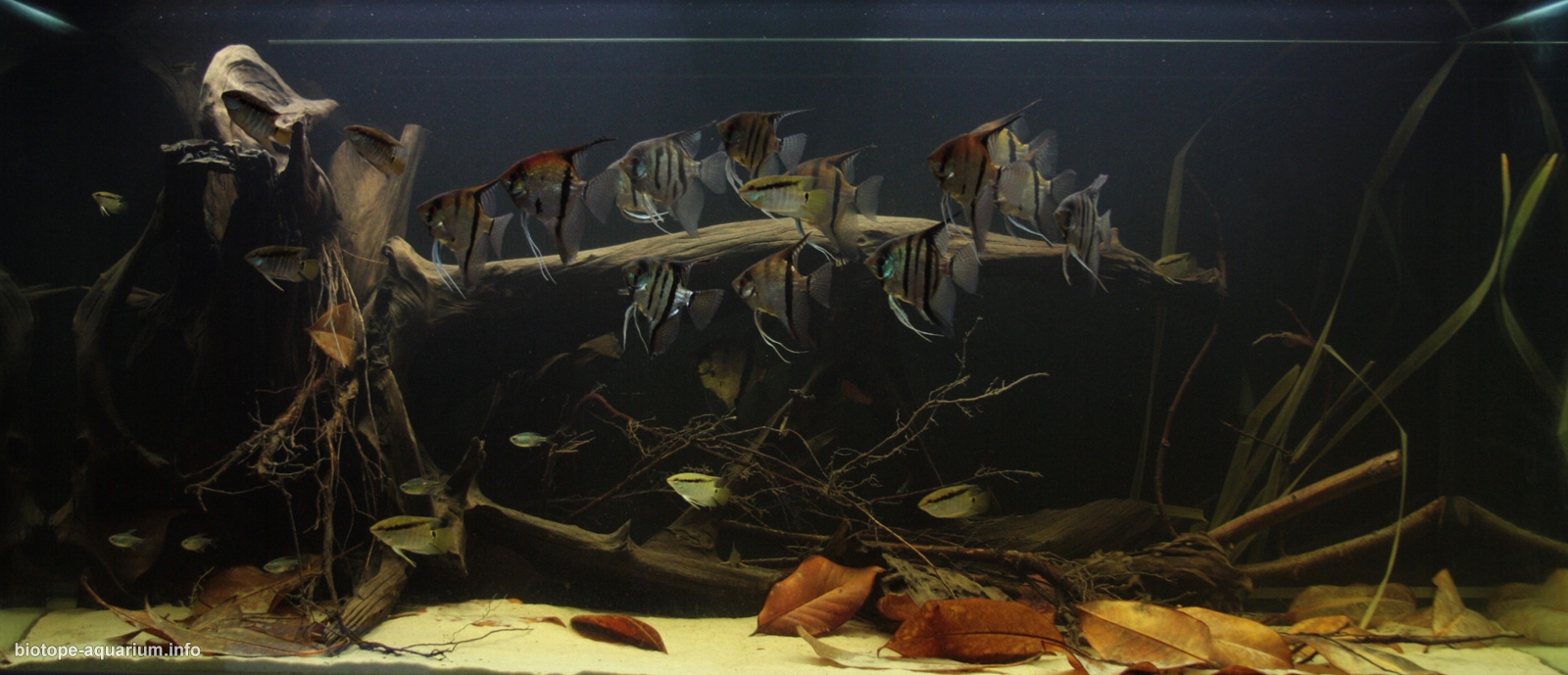The mouth of the Orinoco River
102nd place in Biotope Aquarium Design Contest 2018
![]() Russia. Dmitry Zemskov
Russia. Dmitry Zemskov

Volume: 620 L
Dimensions: 150x60x75 cm
List of fishes: Apistogramma guttata, Pterophyllum scalare, Corydoras sterbai, Ancistrus sp. “L144”, Mesonauta insignis, Moenkhausia pittieri
List of plants: N/A
Description of decorations: Mangrove driftwood, branches and roots of oak, river sand and magnolia leaves. Decor and soil were selected as close as possible to the river biotope and by the video example.
Description of equipment: External filter EHEIM 2078 professional 3 1850 lph, external filter EHEIM 2076 professional 3 1650 lph, JBL AQUACRISTAL UV-C 18W SERIES-II sterilizer, heater for aquarium Eheim 300, Eheim Air Pump 400, light T5 4×54W.
Water parameters: The temperature is 27°C, pH is 5, KH is 20, GH is 8.
INFORMATION ABOUT BIOTOPE
Description of the area surrounding the biotope: South America is rich in many rivers, but Orinoco can be called a unique river. Most of its bed is located in Venezuela. The total length of the river is about 2.74 thousand km. The area of the river basin is 880 thousand km², water consumption approaches 30 thousand m³/s. Taking its origin on the slope of the mountain Delgado Chalbaud, located near Parima (on the border with Brazil), Orinoco turns in a wide arc to the west from the south-west, then to the north and, finally, to the northeast, where the Atlantic Ocean flows into the Gulf of Paria. More specifically, the river goes around the Guiana Highland (plateau) and, crossing the southwestern part of the Guiana Lowland, flows into the ocean bay. In the lower reaches the Orinoco River makes many rivers, forming a river delta. The area of the entire delta is about 41 thousand km². When the floods begin, the river spreads, reaching a width of more than 22 km, and its depth at this moment reaches 100 m. The following rivers are the right tributaries of the Orinoco: Caura, Caroni, Ventuari. Left tributaries: Apure, Guaviare, Arauca, Meta, Vichada. On the river Churun, Caroni tributary there is the highest waterfall in the world: Salto Angel; about 980 meters high. The river is of interest for navigation, since ocean-going vessels can reach the city of Ciudad Bolívar, moving upstream. Ciudad Bolívar is located 435 km from the ocean bay. Orinoco is located in the subequatorial zone. If we talk about feeding the river, then basically the river is filled by abundant tropical rains. Therefore, the river is characterized by sharp fluctuations in the water level: in the dry season, several Orinoco tributaries turn into small standing lakes. It is interesting, that the Orinoco is the clearest example of river bifurcation of the riverbed and river valley into 2 branches. Most of the rivers located in the Orinoco delta are distinguished by an unusually interesting colour of their water. This feature can be logically explaned: the color of the water depends on the characteristics of coastal vegetation and the composition of the bottom soil. Therefore, the water in the tributaries of the river can be light yellow, white, dark coffee, ink-black, and can also vary in this range. Many people have noticed a pattern: the lighter the water is, the more insects and aquatic animals of various species live there. A special feature of the river is the natural canal between two rather big rivers of South America. We are talking about the river Casiquiare, starting as a tributary of the Orinoco and flowing into the Rio Negro, the Amazon tributary. Because of this, a natural channel was formed between the Amazon and Orinoco. The basin contains the largest reserves of heavy oil, known as tar sands. The greatest interest among travelers is caused by national parks, there are quite a lot of them here. Parks such as Henri Pittier, El Avila, La Mukui, Los Nevados and others are located near Orinoco. Especially tourists are fond of the National Park of Sierra Nevada, which provides many opportunities for a wonderful time. Here you can not just enjoy the unforgettable beauty of nature, but also to fly on paraglider and hang-glider. For those who wish, climbing lessons are provided. One of the main attractions of the park is Turtle Mountain, the sacred mountain of the Indians. Therefore, tourists are strictly forbidden to touch its surface and, especially, climb to its top. It is allowed to admire such an amazing natural phenomenon only from afar. It is interesting that the sources of the river were not investigated until the middle of the 20th century. It was difficult to make research because of numerous waterfalls, flooded forests and tributaries.
Description of the underwater landscape of the biotope: The Orinoco River flows through dense forests, mountains and waterfalls and thus a lot of leaves, branches, logs and stones fall into the river. The landscape is also complemented by sand, muddy and clay lowlands and the coast, so the water is often muddy in many mouths.
Description of the parameters of the habitat: The water is relatively calm, turbid. pH is 5, KH is 20 mg/l, GH is 10 ml/L, the average temperature is 25-25°C.
List of fishes and invertebrates occurring in the nature biotope: Apistogramma guttata, Pterophyllum, Corydoras sterbai, Ancistrus sp., Mesonauta insignis, Moenkhausia pittieri.
List of plants found in the nature biotope: Pistia, Eleocharis parvula, Elodea, Vallisneria.
Sources of information:
